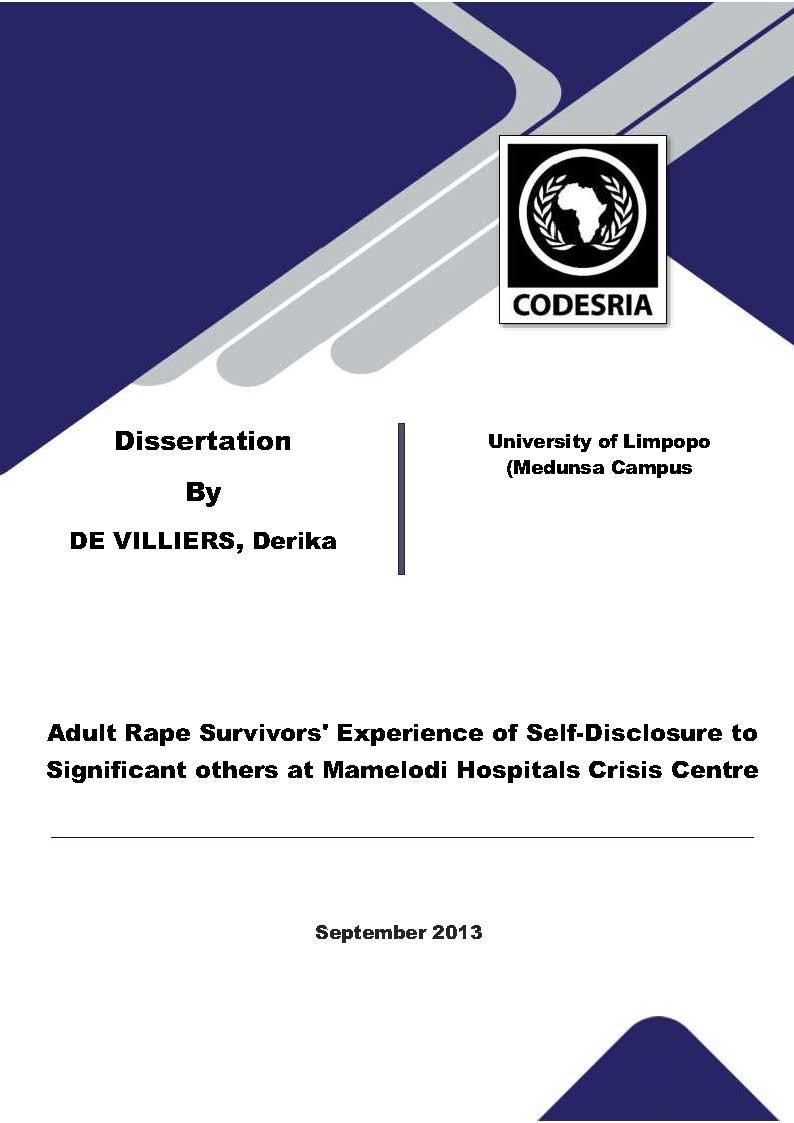Adult Rape Survivors' Experience of Self-Disclosure to Significant others at Mamelodi Hospitals Crisis Centre
Keywords:
Adult Rape Survivors, Experience of Self-Disclosure, Mamelodi Hospitals, worldwide phenomenonSynopsis
This study explored adult rape survivors’ experience of self-disclosure to significant others at Mamelodi Hospital Rape Crisis Centre. Rape is a worldwide phenomenon that is reported daily, drawing attention to its devastating effects on rape survivors, their families and communities. A qualitative exploratory descriptive research design was employed. The researcher chose to utilise purposive sampling for this research study whereby individuals who experienced a rape and who were seeking treatment at the Mamelodi Hospital Rape Crisis Centre were interviewed on their experiences of self-disclosure to their significant others. An in-depth face-to-face semi-structured interview was utilised to collect data from the eight participants who participated in the research study. Data was analysed through content analysis following the Tesch Model of content analysis (Creswell,
1994). Results indicated that that five of the participants chose to disclose their rape experience to their mothers, four participants chose to disclose to their boyfriends and six participants chose to disclose their rape experience to their best friends. The motivating factors that encouraged disclosure were trust and a close emotional relationship. Although seven of the
participants feared judgement and blame from their significant others, the motivating factors was seen as a stronger contributing factor for their disclosure. The participants also indicated that they were very apprehensive about the feedback they anticipated to receive if they would disclose their rape experience to others in their community and feared judgement, blame and stigmatization from them. Further results from this research study indicated that three
Downloads
References
Ahlers, C. E. (2006). Being Silenced: The Impact of Negative Social Reactions on the
Disclosure of Rape. American Journal of Community Psychology, 38, 263-274.
doi:10.1007/s10464-006-9069-9
Ahrens, C. E. (2006). Being silenced: The impact of negative social reactions on the
disclosure of rape. American Journal of Community Psychology, 38, 263-274.
doi:10.1007/s10464-006-9069-9
Ahrens, C. E., Campbell, R., Ternier-Thames, N., Wasco, S. M., & Sefl, T. (2007). Deciding
Whom to Tell: Expectations and Outcomes of Rape Survivors’ First Disclosures.
Psychology of Woman Quarterly, 31, 38-49. doi: 10.1111/j.1471-6402.2007.00329.x
Aiken, L. R. (2000). Psychological Testing and Assessment (10th ed). California: Allyn &
Bacon.
Alarape, A. I., & Lawal, A. M. (2011). Attitudes towards rape among Nigerian young adults:
The role of gender, parental family structure and religiosity. Journal of Gender and
Behaviour, 9(2), 3886-3896. Retrieved from
http://www.ajol.info/index.php/gab/article/view/72117.
American Psychiatric Association (APA). (1980). Diagnostic and Statistical Manual of
Mental Disorders (4th ed.). Washington, DC: Author.
American Psychiatric Association (APA). (2000). Diagnostic and Statistical Manual of
Mental Disorders (4th ed. text rev). Washington, DC: Author.
Anderson, I., & Quinn, A. (2009). Gender differences in medical student’s attitudes
towards male and female rape victims. Psychology, Health & Medicine, 14(1), 105-110.
doi:10.1080/13548500802241928
Babbie, E. (1998). The practice of social research (8th ed.). Belmont: Wadsworth Publishing
Company.
Black, M. C., Basile, K. C., Breiding, M. J., Smith, S. G., Walters, M. T., Chen, J., &
Stevens, M. R. (2011). The National Intimate Partner and Sexual Violence Survey
(NISVS): 2010 Summary Report. Atlanta, GA: National Centre for Injury Prevention and
Control, Centres for Disease Control and Prevention. Retrieved from http://www.cdc.gov.
Bohner, G., Siebler, F., & Raaijmakers, Y. (1999). Salience of rape affects self-esteem:
Individual versus collective self-aspects. Group Processes and Intergroup Relations, 2,
-199. doi:10.1177/1368430204039974
Bramsen, R. H., Elklit, A., & Nielsen, L. H. (2009). A Danish Model for Treating Victims of
Rape and Sexual Assault: The Multidisciplinary Public Approach. Journal of Aggression,
maltreatment and Trauma, 18, 886-905. doi: 10.1080/10926770903291811
Brashers, D. E. (2001). Communication and uncertainty management. Journal of
Communication, 51(3), 477–497. doi: 10.1111/j.1460-2466.2001.tb02892.x
Burgess, A. W., Commons, M. L., Safarik, M. E., Looper, R. R., & Ross, S. N. (2007). Sex
offenders of the elderly: Classification by motive, typology and predictors of severity of
crime. Aggression and Violent Behaviour, 12(5), 582-597. doi: 10.1016/j.avb.2007.02.006
Burgess, A. W., Dowdell, E. B., & Brown, K. (2000). The elderly rape victim: Stereotypes,
perpetrators and implications for practice. Journal of Emergency Nursing, 26(5), 516-518.
doi:10.1067/men.2000.110040
Burgess, A. N., & Morgenbesser, L. I. (2005). Sexual violence and seniors. Brief Treatment
& Crisis Intervention, 5(2), 193-202. doi:10.1093/brief-treatment/mhi016
Burt, M. R. (1980). Cultural myths and supports of rape. Journal of Personality and Social
Psychology, 38, 217-230. doi: 10.1037/0022-3514.38.2.217
Campbell, R., Dworkin, E., & Cabral, G. (2009). An ecological model of the impact of sexual
assault on woman’s mental health. Trauma, Violence & Abuse, 10(3), 225-246. doi :
1177/1524838009334456 Charuvastra, A., & Cloitre, M. (2008). Social bonds and PTSD. Annual Review of
Psychology, 59(1), 301-328. doi:10.1146/annurev.psych.58.110405.085650
Chaudoir, S. R., & Fisher, J. D. (2010). The disclosure processes model: Understanding
disclosure decision-making and post-disclosure outcomes among people living with a
concealable stigmatized identity. Psychology Bulletin, 136(2), 236-256.
doi:10.1037/a0018193
Chaudoir, S. R., & Quinn, D. M. (2010). Revealing Concealable Stigmatized Identities : The
Impact of Disclosure Motivations and Positive First-Disclosure Experiences on Fear of
Disclosure and Well-Being. Journal of Social Issues, 66(3), 570-584. doi: 10.1111/j.1540-
2010.01663.x
Children’s Act. (2005). Government Gazzete. No. 28. Retrieved from
http://www.info.gov.za/view/DownloadFileAction?id=67892
Christofides, N., Webster, N., Jewkes, R., Penn-Kekana, L., Martin, L., Abrahams, N., &
Kim, J. (2003). The state of sexual assault services: findings from a situation analysis of
services in South Africa. The South African Gender-based Violence and Health Initiative.
Rerieved from http://www.mrc.ac.za/gender/reports.htm.
Creswell, J. W. (1994). Research Designs: Qualitative and Quantitative Approaches.
California: Sage Publications.
Creswell, J. W. (1998). Qualitative inquiry and research design: choosing among five
traditions. California: Sage Publications.
Derlega, V. J., & Grzelak, J. Appropriateness of self-disclosure. In: Chelune, G. J. (1979).
Self-disclosures: Origins, patterns and implications of openness in interpersonal
relationships. San Fransisco, CA: Jossey-Bass.
Descombe, M. (2003). The good research guide for small-scale social research projects.
Philadelphia: Open University Press.






